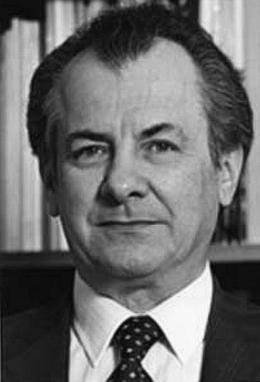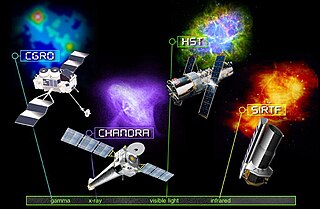
Gerard Peter Kuiper was a Dutch-American astronomer, planetary scientist, selenographer, author and professor. He is the eponymous namesake of the Kuiper belt.

McDonald Observatory is an astronomical observatory located near unincorporated community of Fort Davis in Jeff Davis County, Texas, United States. The facility is located on Mount Locke in the Davis Mountains of West Texas, with additional facilities on Mount Fowlkes, approximately 1.3 kilometers (0.81 mi) to the northeast. The observatory is part of The University of Texas at Austin. It is an organized research unit of the College of Natural Sciences.

The Association of Universities for Research in Astronomy (AURA) is a consortium of universities and other institutions that operates astronomical observatories and telescopes.

Gérard Henri de Vaucouleurs was a French astronomer best known for his studies of galaxies.

NASA's series of Great Observatories satellites are four large, powerful space-based astronomical telescopes launched between 1990 and 2003. They were built with different technology to examine specific wavelength/energy regions of the electromagnetic spectrum: gamma rays, X-rays, visible and ultraviolet light, and infrared light.

The Center for Astrophysics | Harvard & Smithsonian (CfA), previously known as the Harvard–Smithsonian Center for Astrophysics, is an astrophysics research institute jointly operated by the Harvard College Observatory and Smithsonian Astrophysical Observatory. Founded in 1973 and headquartered in Cambridge, Massachusetts, United States, the CfA leads a broad program of research in astronomy, astrophysics, Earth and space sciences, as well as science education. The CfA either leads or participates in the development and operations of more than fifteen ground- and space-based astronomical research observatories across the electromagnetic spectrum, including the forthcoming Giant Magellan Telescope (GMT) and the Chandra X-ray Observatory, one of NASA's Great Observatories.
William Hamilton Jefferys III is an American astronomer. He is a Harlan J. Smith Centennial Professor of Astronomy (Emeritus) of astronomy at The University of Texas at Austin, and an adjunct professor of statistics at the University of Vermont.

South African Astronomical Observatory (SAAO) is the national centre for optical and infrared astronomy in South Africa. It was established in 1972. The observatory is run by the National Research Foundation of South Africa. The facility's function is to conduct research in astronomy and astrophysics. The primary telescopes are located in Sutherland, which is 370 kilometres (230 mi) from Observatory, Cape Town, where the headquarters is located.

The Harlan J. Smith Telescope is a 107-inch (2.7 m) telescope located at the McDonald Observatory, in Texas, in the United States. This telescope is one of several research telescopes that are part of the University of Texas at Austin observatory perched on Mount Locke in the Davis Mountains of west Texas. The telescope was completed in 1968 with substantial NASA assistance, and is named after Harlan James Smith, the first Texas director of McDonald Observatory. Smith was the Observatory Director for 26 years.
David Stanley Evans was a British astronomer, noted for his use of lunar occultations to measure stellar angular diameters during the 1950s.

StarDate is a science radio program of The University of Texas at Austin McDonald Observatory, broadcast on over 300 radio stations. It is a daily guide to the night sky and breaking astronomical news. Typically heard without formal introduction, StarDate is a self-contained science news feature interwoven with routine radio programming. It is the longest-running science outreach program on U.S. radio.
James Adolph Westphal was an American academic, scientist, engineer, inventor and astronomer and Director of Caltech's Palomar Observatory from 1994 through 1997.
Kepler-4 is a sunlike star located about 1610 light-years away in the constellation Draco. It is in the field of view of the Kepler Mission, a NASA operation purposed with finding Earth-like planets. Kepler-4b, a Neptune-sized planet that orbits extremely close to its star, was discovered in its orbit and made public by the Kepler team on January 4, 2010. Kepler-4b was the first discovery by the Kepler satellite, and its confirmation helped to demonstrate the spacecraft's effectiveness.

Steven Scott Vogt is an American astronomer of German descent whose main interest is the search for extrasolar planets.
The SFA Observatory (SFA) is an astronomical observatory located 17 km (11 mi) north of Nacogdoches, Texas (USA). The observatory is owned and operated by Stephen F. Austin State University (SFASU), and opened in 1976. It is used for undergraduate instruction and for graduate-level research.
James Richard Houck was the Kenneth A. Wallace Professor of Astronomy at Cornell University.

Charles Mattias ("Matt") Mountain is currently the President of the Association of Universities for Research in Astronomy (AURA) which designs, builds, and operates telescopes and observatories for the National Science Foundation (NSF) and the National Aeronautics and Space Administration (NASA). AURA's NASA center is the Space Telescope Science Institute (STScI), responsible for the science mission for the Hubble Space Telescope, the science and operations for the James Webb Space Telescope, and the MAST data archive. AURA's NSF centers are Gemini Observatory, the National Optical Astronomy Observatory (NOAO), and the National Solar Observatory (NSO). Dr. Mountain and AURA are also responsible for the NSF construction projects: the Daniel K. Inouye Solar Telescope (DKIST) on Haleakalā, Hawaii and the Large Synoptic Survey Telescope (LSST) on Cerro Pachón in Chile.
Don E. Winget is an American astronomer and astrophysicist who studies white dwarf stars. He is the Harlan J. Smith Centennial Professor in Astronomy and a university distinguished teaching professor at the University of Texas at Austin.
Pedro Antonio Valdés Sada is a Mexican astronomer, specialising in extra-solar planets (exoplanets), planetary astronomy and stellar astronomy. As of December 2015, he is associate professor and researcher at the Departamento de Física y Matemáticas at the Universidad de Monterrey.
Anita L. Cochran is an American astronomer, planetary scientist, and senior research scientist at the University of Texas at Austin. She is also the assistant director for research support at the McDonald Observatory. She focuses on the study of primitive bodies in the solar system and the composition of comets.











